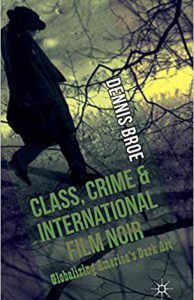There are many different approaches to the analysis of film noir, since film studies today deal with almost any facet, be it technical, stylistic or director specific. Dennis Broe, however, has the emphasis on the social-cultural and most of all the working-class aspects of these films.
 He locates the origins of film noir to a large part in French productions from the (pre film noir) 1930s, where he sees the expectations and the future of the protagonists, mostly working class, massively disillusioned.
He locates the origins of film noir to a large part in French productions from the (pre film noir) 1930s, where he sees the expectations and the future of the protagonists, mostly working class, massively disillusioned.
In fact, the overwhelming sense of being doomed forever in a struggle for economic survival and life at the mercy of (often corrupt) city officials and the police force, the working-class protagonist turned out to be pessimistic, disappointed and finally violent. A similar bleak outlook on life – as early critique on the American capitalist system and its values – was portrayed in a few US movies during WWII; to be continued on a large scale after the war.
This development was overshadowed by various strikes in 1945 and 1946 as these “strikes were accompanied by optimism on the part of filmmakers about the ability of cinema to grasp the social issues of the day. Both hopes were dashed in 1947 with the outlawing of the strikers’ actions by the Taft-Hatley Act and the HUAC attack on Hollywood, seen by studios as means of curbing a resurgence of labor and guild power in the industry,” and traditionally, left filmmakers very often were fascinated by the combination of elements from the crime film with social struggles, e.g. explaining crime, violence and desperation finally as the result (and critique) of present social standards.
As this information on American film noir is more or less common knowledge today, Broe devotes the majority of his book to demonstrate those aspects and very similar developments in other nations and their respective movie output at a certain time; hence his title “International Film Noir.” In the four chapters, he investigates the post-war film noir production of Britain (a country that became a new home to American filmmakers being blacklisted in Hollywood), Japan and Italy; and how it changed during the Cold War.
Each country naturally drew from a very specific tradition of movie making; nevertheless, the American noir movies fostered a special adaptation in the respective countries. The structure of each national large chapter is subdivided into sections on social, political, and economic situation, then the production modes that were available in post-war times, followed by the state of social cinema around, while the fourth section presents the country’s most important films and their meaning for the canon of film noir.
The concluding part of the study deals with contemporary neo-noirs, that Broe sees mostly present in Scandinavia, Asia and the Mediterranean.
In large parts, he bases his book on the idea of a transnational labor study and the outcomes of international labor movements of various sorts and periods. Far from simply labeling all dark and pessimistic post-war productions in the aforementioned countries “noir,” he makes clear his (own very leftist) point and presents plenty of evidence.
While in the US movies the struggle of the working class in his view may have been in some manner concealed, since in American noirs it is often the solitary citizen or the lone criminal who challenges the police force or the representatives of capitalism; Broe sees the political angle of such a plot much stronger represented in French noirs where entire groups serve as the agents of the working class. Who are being labeled criminals after efforts to escape their social position. “This study …. argues that noir articulated a global expression of resistance against the installation of a corporate order that needed to be sustained and rationalized by fashioning a new, permanent, war.”
Class, Crime and International Film Noir may be no easy reading for beginners, i.e. it may not be suitable as an introduction to the style. However, it reveals many interesting political details of the respective national governments and thereby offers approaches to interpret many (international) noirs as masterpieces that also carry messages of social criticism and anti-capitalism. Broe’s interpretation is one possible way of defining film noir (while there are many others). Nevertheless, it is a solid inquiry where much evidence is produced in a strictly analytical and academic way.
Dennis Broe has published on American working-class history and film in Film and History, Jump Cut and other journals. He is a Professor of Media Arts at Long Island University. His Film Noir, American Workers, and Postwar Hollywood (2009) is a Choice Outstanding Academic Book.
Review by Dr. A. Ebert © 2016
Dennis Broe. Class, Crime and International Film Noir: Globalizing America’s Dark Art. Palgrave Macmillan, 2014, 233 p.
